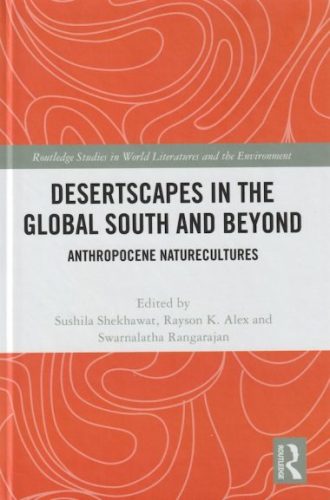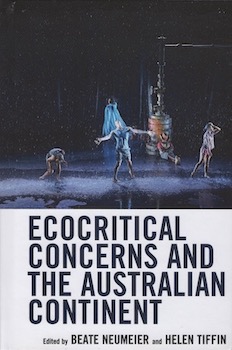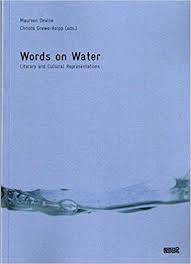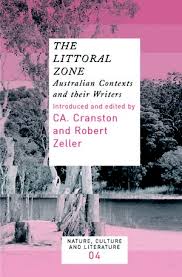A number of these chapters and journal articles can be downloaded through the University of Tasmania’s ecite system (URLs are provided).
CHAPTER: “Inheriting Isotopes: the Androcene and the End of Nature in the Great Victoria Desert A-Bomb Test Sites.” Desertscapes in the Global South and Beyond: Anthropocene Naturecultures, eds. Sushila Shekhawat, Rayson K. Alex, Swarnalatha Rangatajan. Routledge, 2024 (pp. 27-45). DOI: 10.4324/9781003280774-4

‘Homo Sapiens manufacture not one, but two, threats to life on Earth namely nuclear capability and climate change. While Cold War nuclear proliferation is broadcasting radioactive strontium-90 isotopes as a result of nuclear fission, Watson and Crick are parsing the molecule of life, DNA (deoxyribonucleic acid). Configured as a double stranded helix, DNA offers a short-hand formula for life’s complexities, (A = T and C = G). The four-letter combinations carry genetic instructions—sentences morphing into biological metalanguages responsive to mutagenic chemical exposure and radiological fallout: a double helix of genetic, and Man-made, materials. What do we get when we add C44H8C125 (mustard gas) or 90SR (Strontium-90) to ATCG, the four-letter equation? Lost potentiality? A new diversity? Body-ecology entanglements expose the narrative legacy inhabiting desert bodies’. (Cranston 27).
JOURNAL ARTICLE: “The Zwergroman: Literary Dwarfs under the Australian Gaze.” Antipodes, vol. 36, no. 1, 2022, pp. 78-93.
https://muse.jhu.edu/issue/4962

‘Dwarfism’s connection with Australia’s mythic and literary history is remarkable enough to suggest here that it occupy its own subgenre in literature, the zwergroman (m.). Australia’s branding as the “Antipodes” geographically recalls its colonial past; mythographically the imaginative configuration was as an underworld of opposites ruled by the diminutive King of the Antipodes (Loomis 110). Thus, the zwergroman is frequently fashioned from the Celtic myths of the colonizing power along with the shaping power of colonial processes‘ (p.78)

2020 “Reconstructing Representations: ‘Australia’ as Ecocritical Andragogy.” Ecocritical Concerns and the Australian Continent, edited by Beate Neumeier and Helen Tiffin. (Ecocritical Theory and Practice Series, Rowan & Littlefield International). Chapter includes a specific focus on climate change through the work of SA artist, Hans Heysen; Patrick White’s Voss, and Gabrielle Lord’s cli-fi Salt, while demonstrating ecocritical methodologies. http://ecite/utas.edu.au/144644 DOI: 10.4324/9781315167343-4
‘Cranston’s chapter, which is by far the longest in the volume (even taking into account its lengthier bibliography and its inclusion of illustrations), rightfully occupies a central place in the book. Although it is set in the “colonial arts section,” it offers a fast-paced and thought-provoking exploration of how the “Two Cultures” of the humanities and science must collaborate to guide humanity towards a truly ecological world-view. Drawing from a wide field of representations, namely historical travel writing, the fine arts, film, fiction (from highbrow writing by Patrick White, Murray Bail, and Alexis Wright to cli-fi by Gabrielle Lord), Cranston usefully explores the divergence between biocentric (concerned only with the animate world) and ecocentric approaches, and signals how the latter, which grants humans and non-humans no special importance beside the way they influence the ecosystem, is “guaranteed to antagonize postcolonial feminists, especially third-world women of colour,” as well as “Animal Rights advocates”‘. (Anne Le Guellec-Minel, Commonwealth Essays and Studies 44.2, 2022, p.173)

2019 “Eco churches, Eco Synagogues, Eco Hollywood: 21st-Century Responses to Lynn White, Jr.’s and Andrew Furman’s 20th-Century Readings of Environments in Crisis” in Ecocriticism and Environmental Communication, Routledge, S. Slovic, S. Rangaranjan, V. Sareswaran (eds), New York, pp. 36-54. ISBN 9781138053137 (2019) http://ecite.utas.edu.au/129455
“CA.Cranston’s [chapter] startling for the subtlety and nuance of the thinking, moves comfortably among Judaic concept–such as the mitzvah of tzedakah (צדקה) on the one hand, and ‘real-world influence’ (49) on the other–and both summarises a great deal of material and adds significantly to existing research” (Simon Estok, Green Letters, p. 229).

2017 “Climate and Culture in Australia and New Zealand”, with Charles Dawson (NZ). A Cambridge Global History of Literature and the Environment, edited by Louise Westling and John Parham, CUP. ISBN: 978131621257 http://ecite.utas.edu.au/112914

2012 “An Ecocritical Reading of Aravind Adiga’s The White Tiger”. Contemporary Contemplations of Ecoliterature, edited by Suresh Frederick. New Delhi: AuthorsPress, pp. 228-266.
[Name published erroneously as C.A. Caranston, “An Ecocritical Reading of Aravind Adiga’s The White Tiger”]. (37mgb) http://ecite.utas.edu.au/86099
LITERARY ECOCRITICISM TEACHING RESOURCE: This chapter, with more than 2000 downloads, provides an excellent teaching resource and demonstration of the application of ecocritical methodologies.
2009 “Literary Ecoconsciousness” in Reading Down Under: Australian Literary Studies Reader, edited by Amit Sarwal and Reema Sarwal. New Delhi: SSS Publications, pp. 379-385. ISBN No. 81-902282-1-0
2009 “From Shanty to Shanti: Teaching Australian Literature in India” in Special issue: ‘Australian Literature in a Global World’, JASAL Vol. 9, pp. 1-14. http://www.nla.gov.au/openpublish/index.php/jasal/index
2009 “Challenging Contemporary Ecocritical Place Discourses: Military Brats, Shadow Places, and Homeplace Consumerism” Indian Journal of Ecocriticism. Vol. 2, pp. 72-89. A bio-ecology account of growing up in military postings. http://eprints.utas.edu.au/9597/

2008 “Wet, in the Mindscape of the Dry” in Words on Water: Literary and Cultural Representations, edited by Maureen Devine and Christa Grewe-Volpp. Wissenschaftliche Verlag Trier: Germany http://eprints.utas.edu.au/8724/
LITERARY ECOCRITICISM TEACHING RESOURCE: The chapter “Wet, in the Mindscape of the Dry” in Words on Water provides an excellent teaching resource demonstrating, among other things, an ecocritical reading of Jack Hibberd’s A Stretch of the Imagination. It discusses also WW2 immigrant responses to Australia’s vernacular building material, corrugated iron.

“In this, the first collection of ecocritical essays devoted to Australian contexts and their writers, Australian and US scholars explore the transliteration of land and sea thought the works of Australian authors and through their own experiences” Back Cover
2007 “Setting the Scene: Littoral and Critical Contexts”. Robert Zeller and CA. Cranston, in The Littoral Zone: Australian Contexts and their Writers: Ecocriticism. Amsterdam & New York: Rodopi, pp. 7-30.
http://eprints.utas.edu.au/4692/
2007 “Islands” (ecocriticism) in The Littoral Zone: Australian Contexts and their Writers, edited by CA. Cranston and Robert Zeller, Amsterdam: Rodopi, pp. 219-260). http://eprints.utas.edu.au/4749/
2004 Chapter, “C.J. Koch (1932-).” Dictionary of Literary Biography, Volume Two Eighty Nine: Australian Writers, 1950-1975, edited by Selina Samuels. Bruccoli Clark Layman, pp. 196-206. http://eprints.utas.edu.au/535/
2003 “Rambling in Overdrive.” (Ecocriticism). Tasmanian Historical Studies 8 (2 ): 28-39. http://eprints.utas.edu.au/528/
2002 Chapter, “John Morrison”. Dictionary of Literary Biography Volume Two Hundred Sixty: Australian Writers, 1915-1950, edited by Selina Samuels. Bruccoli Clark Layman, pp. 239-249. http://eprints.utas.edu.au/53
2001 Australian Literature Gateway and Scholarly Electronic Text and Image Service (SETIS citation 14:2) e-published “Sentimental Jonah’s Heart of Stone”. Originally published in Australian Literary Studies, 14 (October 1989): 216-228.
2001 “Tasmanian Nature Writing and Ecocriticism”. Special issue. Australian Literary Studies in the 21st Century, edited by Philip Mead. ASAL: Hobart, pp. 59-67. http://eprints.utas.edu.au/527/